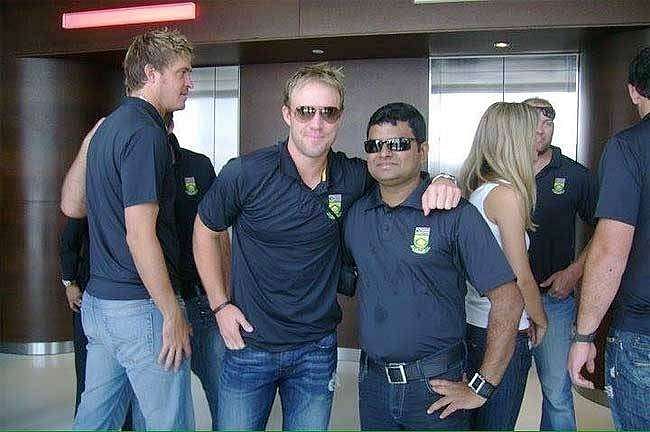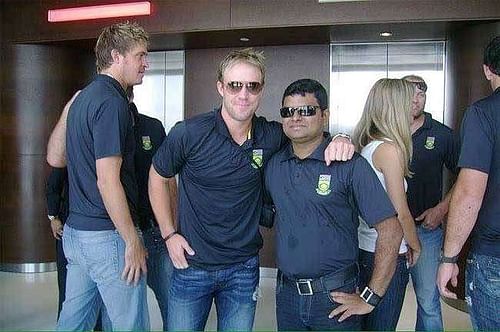
The brains behind South African cricket is a man from Chennai - Prasanna Agoram

A lot of work has gone into South Africa's transition to become one of the toughest teams to beat in Test cricket. The likes of Graeme Smith, Jacques Kallis, Hashim Amla, AB de Villiers and Dale Steyn have contributed immensely to the cause and have been pivotal in South Africa's terrific run to the top.
A close look at the statistics reveals that since 2010, South Africa has a win-loss ratio of 2.166 in Tests, with more wins than losses against all nations except India, to whom they lost 4 games as opposed to 2 wins.
The overall W/L ratio in Tests for South Africa is 1.096 but it would be harsh to judge them before 1992. A better comparison would be that to six years prior to 2010 – from the period of 2004-2010, the Proteas’ Tests side has a W/L ratio of 1.318.
The likes of Kallis, Smith, Amla, Steyn and de Villiers were present during both these periods. Possibly, Amla and de Villiers were new to the scene in the earlier half but Smith, Kallis and Ntini were in their prime then.
So what changed post-2010? Why has there been such a drastic change in their Test fortunes?
The men in the background have played a big part in their success and one name that stands out is that of Prasanna Agoram, the Technical Strategy Analyst at Cricket South Africa. Agoram is among the most important members of the support staff at CSA now, playing a vital role in South Africa's surge to the top of the Test rankings.
Early life
Agoram hails from Chennai, India, and completed an engineering degree with a gold medal in Electronics and Telecommunication Engineering from Adhiyamaan College of Engineering, Hosur.
He had played under-19 cricket for Tamil Nadu but later turned to umpiring. He soon discovered that his passion lies in working behind the scenes and trained to become a video analyst.
He was inducted into the National Cricket Academy (NCA) in 2004 and was a video analyst for the Under-19 world Cup in 2006 in Sri Lanka courtesy Venkatesh Prasad.
Connection with Indian players
Agoram later became the technical head of NCA, helping the likes of Virat Kohli and Rohit Sharma.
“I have worked with every player from that time who is now playing for India. I have seen them when they were small boys. I have seen Virat Kohli during his Under-15 days in North Zone 2004-05. None of them are strangers to me. Be it Ishant, Rohit, Cheteshwar, Ajinkya, Ravindra Jadeja, I have worked with them all in NCA during their junior days,” he had said while speaking to Times of India when South Africa toured India earlier this year.
“I had given an interview in 2006 and told that the next generation of 10000 Test runs will be Virat Kohli and Rohit Sharma and Cheteshwar Pujara when I saw them during Under-19 World Cup,” said the technical strategy analyst.
The introduction to IPL
The inaugural IPL proved to be a launching platform for the Chennai-based analyst, and became a part of the Royal Challengers Bangalore setup. During the IPL, he had the opportunity to mingle with several international stars and this opened a wider perspective to him.
The RCB team of 2008 had numerous players from South Africa like Jacques Kallis, Mark Boucher and Dale Steyn. The head coach, Ray Jennings, father of current England opener, Keaton Jennings, also hailed from South Africa.
The Proteas stars were impressed with Agoram's work ethic and analysis from behind the scene and a word from them prompted CSA to hire him in 2010 for their tour of Abu Dhabi as Performance Analyst.
“When I first got onto the bus with the likes of Graeme Smith and Kallis, it felt like facing my first ball in Test cricket with Steyn steaming in,” Agoram had said then, speaking of his first experience in the Proteas side.
The 2011 World Cup game against India
In the 2011 World Cup which India won, South Africa were the only side to beat the champions. In the group stage game, South Africa recovered from a Sehwag-Sachin storm to bowl out India for 296.
In the chase, after stuttering, Robin Peterson helped himself to a cameo off Ashish Nehra in the final over to win the game for the Proteas.
Agoram played a vital role in the victory that not many know about. He had analysed and understood that the strength of India's bowling at the death lay in the hands of Zaheer Khan, the wily old fox, who could mix slow balls and cutters with yorkers to cut down scoring at the death.
The shrewd analyst forced South Africa to take the batting power play early after Zaheer's second spell so that Dhoni would be forced to give Zaheer extra overs early on, giving him only one remaining over at the death.
The move proved to be a masterstroke as Zaheer ran out of overs, prompting Dhoni to resort to Nehra in the last over and the rest is history.
Relationship with players
Agoram has become an integral part of the Proteas setup and has been critical in the growth of several young players in the team. Such has been his nature of work that he spends as many as 320 days away from home. However, it has helped him build a strong relationship with players, despite his minimum knowledge of Afrikaans.
His enthusiasm and contribution to ‘Protea Fire’ has made him a favourite among the support staff with several players using his technical advice to improve their game.
Hashim Amla has been a big fan of Agoram ever since he started out with the Proteas. In 2012 at Lord's, Amla drew a box in the air after reaching his hundred to acknowledge the role of the technical analyst in his crucial century.
"It was just an acknowledgement for the amount of work he puts in,” Amla had said when queried about the gesture. "He said something really inspirational to me before the series which is why I did it," Amla added, though he wouldn't reveal what it was.
Dean Elgar had scored a magnificent ton against Sri Lanka in their home ground at the onset of his career and made a gesture by running his fingers over his lips, signalling to the technical analyst to shave off his moustache, an outcome of a bet between the two.
Turning Imran Tahir into a world-class spinner
Imran Tahir, who struggled to nail down a spot in the Proteas setup despite his good returns in the 2011 World Cup, also credited Agoram for contributing immensely in his comeback in 2013. He had a horrid Test debut against Australia and was dropped from both the Test and ODI squads, missing a total of 16 matches before returning to the side in the series against Pakistan in Abu Dhabi in 2013.
Tahir's issue was that he had too many variations, and mixed them up far too often which resulted in the surprise element of his variations becoming a predictable thing for batsmen.
“I must give credit to Prasanna. He’s been really helpful with the video analysis, which has helped to show me how and where to bowl to the opposition. Before that, I just used to bowl. There were no plans and I didn’t know what to do. You go on a non-turning wicket and you’re trying to spin the ball. Obviously, that’s difficult," Tahir said professing his admiration for the work done by him.
Working with de Villiers
Agoram is believed to be actively involved in forming strategies for South African batsmen, with specific areas to bowl to the opposition or when a particular batsman is most effective in a game.
This has extended to AB de Villiers being used in a floating role in the T20I side, which has come in for heavy criticism from experts. But South Africa, under Domingo, has continued to use de Villiers as a floater in T20s.
The observant analyst is believed to be the main reason behind this, as statistics from him reveal that the dynamic batsman is most effective when walking in to bat after the 10th over, irrespective of his batting position.
de Villiers has an average below 20 in T20s when coming in to bat before the 10th over, prompting the Engineering Gold medallist to suggest using the champion batsman as a floater in T20I based on match situations.
He, however, acknowledges the freak that de Villiers is. “Whatever technical corrections AB wants to make, he does it himself, sometimes even during the game. For the last six years, he is one player, who has seen his batting less than anyone else. Some players like to watch their videos on the same day, some even at the ground while the match is on. But this man whether he scores 100 or duck, he hardly bothers about going through technical aspects,” Agoram had said in an interview with TOI.
Development of Mr. Cricket tool
Having been with the setup for four to five years, he wanted to expand the technological aspect of cricket in South Africa and took it upon himself to enhance his role from a video analyst to someone who influences outcomes.
He developed an innovative tool, named Mr. Cricket, which enables intelligent access of videos and technicalities during the game. It helps Agoram to reach out to respective staff to correct deviation in plans during the game.
The tool enables access to videos from the archive and consolidate plans discussed in team meetings. For instance, if there is a deviation in the bowling areas to a particular player in the opposition from what is discussed in the team meeting, the video analyst can instantly identify it during the game and relay the same to the respective coach. The tool even props up the percentage of execution of discussed plans.
Setting a benchmark for other Performance Analysts
In his own words, performance analysts have to expand their horizon to influence the outcome of games. He had said in a video released by CSA, "The job of a performance analyst is not sitting and logging the information happening on the field. The important thing is to analyse strategies, trends and plans against opposition players. For instance, when playing in Australia or New Zealand, what exactly is the length to bowl, what length has been successful in the past, where to bowl in the death overs, what field to set etc."
His contract does not expire until 2017 and he can very well expect it to be renewed given the weightage of his contributions to the success of the Proteas.
He has changed the role of performance analysts in cricket with his innovative ideas and tools, and South Africa, at the moment, are a step ahead of other sides when it comes to plotting strategies for matches courtesy ‘P-dogg’, as Agoram is fondly called in the dressing room.
As Morne Morkel puts it, "We will be smart enough to give Prasanna a passport then and lock him with the South African team forever.”